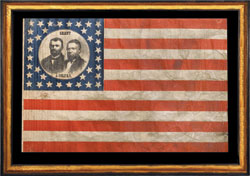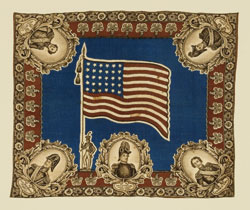Stars and Stripes that Solicit Votes
As the commercials, yard signs, and Web ads subside with the election of a new national leader, artifacts from a different era remind us that campaign materials have always played a significant role in presidential politics. During the 19th century, platform slogans and portraits graced the stars and stripes of Old Glory, as displayed in a September exhibition at GW’s Luther W. Brady Art Gallery. Alumnus Mark Shenkman, MBA ’67, and his wife, Rosalind Shenkman, loaned their collection of historic wool, silk, and cotton political flags as surviving examples of this unique campaigning device. Two of these distinctive pieces are shown above. One is a 36-star American parade flag made for the 1868 presidential campaign of Gen. Ulysses S. Grant and Schuyler Colfax, the Republican candidates. The other is a portrait-style kerchief, made for the 1848 presidential campaign of Zachary Taylor with the portraits of four other Mexican War officers. Although the U.S. Congress outlawed the use of text or portraits on the official insignia in 1905, the practice continued for a number of years.
 Jugate Portrait of Ulysses S. Grant and Schuyler Colfax, 1868, Glazed cotton, 19-1/2” x 29” |
 Zachary Taylor Kerchief, 1848, Printed cotton, 24” x 29” |
